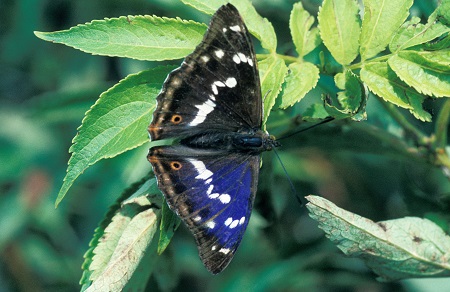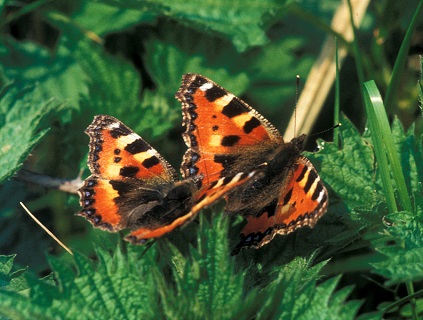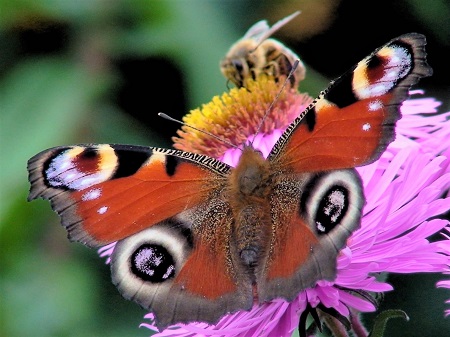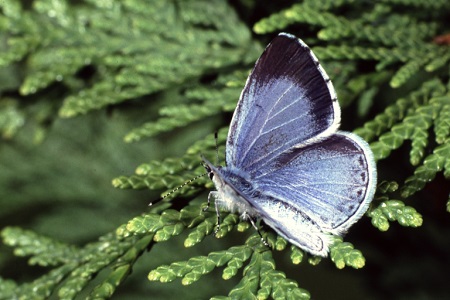|
9. Behaviour in space
Behaviour in space is controlled by several traits. Four of these traits are considered in detail, but to produce figures is difficult because it concerns observations on butterflies in their natural environment.
Studying the behaviour of butterflies in space is easier than recording that of nocturnal moths because the former are active during daytime, so they are easier to follow in the landscape. What a butterfly will do when flying around, apart from search for nectar, depends on the phase of its adult lifestyle.
1. From stay-at-home to migrant
Some butterflies will remain all day in a small area whereas others visit a place fleetingly and leave soon to continue their way. There are stayers and movers. These behaviours have a hereditary origin.
Short lived butterflies have no chance to look around, their life is too short, but long living species may also stay at the site where they were born. Such individuals will learn after hatching the local details and will stay within certain boundaries in the vegetation or in the landscape, for example the silver-spotted skipper (Hesperia comma). Adults of other species live as nomads. They will leave the spot of birth immediately after hatching and fly far away in search of a new suitable site, for example the small white (Pieris rapae). There they will stay for some time and look carefully for suitable breeding places. A much more loose relation between butterfly-home and landscape occurs in migrants. Their home changes with the season, they will arrive in early summer and leave in autumn.
However, they may be very precise when looking for a spot to lay their eggs.
Four types of behaviour with regard to the use of sites are listed here:
1. Stays at the site, ‘stay-at-home’, explores the site only.
2. Stays within a small area, ‘scout’, explores the area.
3. Leaves the site, ‘nomad’, explores the landscape widely.
4. Leaves the site but may return in another year ‘migrant’.
2. Trace the mate
Among butterflies there is great variety in making contact with the opposite sex. The range of different types of behaviour runs from ‘hot-blooded’ males which seem to rape the virgin females and which patrol the whole day at sites where fresh butterflies are expected. The opposite behaviour is that of ‘timid’ males which gather on a meeting place where willing females invite the male of their choice. Details in the landscape are involved in all these actions. Well known is the hill-topping behaviour in a hilly landscape by the swallowtail (Papilio machaon), tree-topping in a woodland by the purple emperor (Apatura iris) and the use of the spots of bare soil in a short vegetation by the grayling (Hipparchia semele). There are much more subtle landmarks which are important in tracing a mate.
Butterflies use olfactory cues very little, contrary to moths. Smell only plays a role during a meeting.
Then it is important to recognize the species and the sex. In the world of the moths there are examples where males can find the females from very great distances, many kilometres.
|
|
Behaviour in space is in general poorly known because it is based on observations
in the field.
In the case of butterflies it concerns mainly their orientation within
the landscape.
Visual and olfactory stimuli provide guidance through the different phases of the butterfly's life: finding a mate, a place for reproduction, a source of food.
For some species the choice of a meeting point is spectacular.
In the case of the purple
emperor (Apatura iris) it is a master tree in the wood,
of the small tortoiseshell
(Aglais urticae) a nice but not too large a clump of stinging nettle and of the
swallowtail (Papilio machaon) a hilltop or a remarkable point in the landscape.
Photograph: Frits Bink ©. |
3. Orientation in the landscape
Butterflies have good eyes and they can recognize patterns in vegetation and landscape. Their antennae work as a flight speed indicator and as an olfactory sense. A butterfly without antennae is completely at a loss. Also memory plays a role in the behaviour of the individuals; they can learn how the world looks like around their favourite spot.
The way they move around in the landscape depends on the details to which the butterfly reacts. These may be details on micro-scale like patterns in the structure of the vegetation, or on meso-scale such as wood-edges, roadside verges and riverbanks. Some butterflies are able to orientate on macro-scale in extended landscapes such as coastal dunes, heathlands and countryside and even to cross over seas in a straight flight; this latter means that orientation by the position of the sun or by the Earth’s magnetic field is involved in their navigation.
4. Oviposition
There are butterflies which are so imprecise in the way of egg-laying that they just drop the eggs regardless of where the female strays. This way of oviposition occurs among grass feeding species; the only selection the adults make is that of a suitable grass vegetation. Well known examples are the ringlet (Aphantopus hyperantus) and the marbled white (Melanargia galathea).
The small tortoise shell (Aglais urticae) and the peacock (Aglais io) lay their eggs in one batch of about 200-300 eggs on a stinging nettle (Urtica dioica), a quite common plant species that grows everywhere on fertile, humid soil. But the butterflies are very choosy and spend a lot of time in selecting a particular plant. The small tortoiseshell prefers a site in the open, the peacock prefers rather a marshy site along a brook or wood edge.
Very accurate egg-laying occurs among the hairstreaks (Theclinae), especially in the case of the purple hairstreak (Favonius quercus) that lays about six eggs per day during its oviposition period of about three weeks. The butterfly starts egg-laying as soon as the tree develops winter buds and it lays one egg per bud in the outer contours of the crown of the tree.
Besides the many examples of butterflies which are precise in the selection of site and host plant, there are also examples of butterflies that sometimes oviposit on an unnatural host-plant. This odd behaviour can be considered as a trial to test if this particular plant may be also a suitable host-plant.
5. Spreading of risk
Using the word ‘spread’ means here the spread in the lifecycle which has an hereditary base. In particular it is considered as a survival strategy from unpredictable adverse weather periods. This phenomenon is called ‘bet-hedging’. In general it works by being out of phase with the average lifecycle; in case of a calamity the individuals that are the forerunners or those which are behind will survive and save the population.
In breeding studies several phenomena can be related to ‘spread’:
1. Variation in larval growth rate.
2. Variation in ending diapause.
3. Repeating diapause after a short period of activity.
4. Prolonging diapause over several years (occurs often in pupal stage).
5. Behaviour of an egg-laying female which spreads oviposition over both time and space.
6. Required space
The estimation of the space necessary for the continued survival of a particular species is an important issue when considering management of nature reserves and in conservation policy.
The spatial requirements of a population varies from a site of less than one hectare as in the silver-studded blue (Plebejus argus) up to nearly the whole continent as in the red admiral (Vanessa atalanta).
The types of required space for a population can be estimated with regard to the lifestyle of the involved species:
1. For a ‘stayer’, one single site, or a cluster of small sites together, can be sufficient (1-25 ha)
2. For a ‘scout’, a system of small nearby suitable localities in the landscape (25-100 ha),
3. For a ‘nomad’, a system of small locations dispersed in a landscape (1-100 km ²),
4. For a migrant, a system of small dispersed locations within the region.
How the composition of the fauna of a small locality may reflect the species occurring in that region and those that effectively can use some qualities of the small site can be answered by an exercise.
The following procedure may clarify both how to estimate the qualities of the spot situated in its surrounding and what species are to be expected.
Exercice
1. Read the data from a GPS-receiver for the coordinates of the spot. For example in hexagonal notation 51° 59’ 34”N – 5° 40’ 52”E, or in decimal notation 51.992778 N – 5.68111 E, for a garden in the village Bennekom. This garden is a 500 square meter parcel with a house and a stretch of grass.
2. Input the coordinates into a Google Chrome entry and the satellite picture will become visible in fine detail. How the garden is situated in the landscape can be seen by the following steps in selecting the scale as shown on the screen:
20 m, garden in details including the gardens of the neighbours,
50 m, garden in its surrounding up to a distance of 200 m,
100 m, half of the area of the village,
200 m, nearly the whole village,
500 m, whole village and part of the surrounding villages,
1 km, the picture on the screen is equivalent a map scale of 1:25.000, the surrounding villages, river Rhine, heathland, woodland, arable fields are all visible.
Table 9-1. Reading satellite pictures on the screen, from spot to country by ten steps.
| step |
on screen |
scale |
examples of corresponding maps |
| 1 |
20 m |
1 : 320 |
spot, coordinates read from GPS-receiver |
| 2 |
50 m |
1 : 1000 |
site, basic map for technical networks |
| 3 |
100 m |
1 : 2000 |
site, basic map for construction works |
| 4 |
200 m |
1 : 4000 |
sketch map for management works |
| 5 |
500 m |
1 : 12.500 |
aerial photograph, minute map |
| 6 |
1 km |
1 : 25.000 |
standard topographic map, large size |
| 7 |
2 km |
1 : 50.000 |
standard topographic map, small size |
| 8 |
5 km |
1 : 150.000 |
regional map |
| 9 |
10 km |
1 : 300.000 |
tourist road map |
| 10 |
20 km |
1 : 600.000 |
regional atlas map |
In this way you will see how the garden is situated in the landscape and which butterfly species that have their home nearby or far away can be expected to reach the garden. For example, the swallowtail (Papilio machaon) had been seen several times in this small garden and even the larvae.
About one and a half kilometre from this garden there is a big allotment garden complex at De Eng of Wageningen, where the species can maintain a population for several years. At the topographical map scale 1:25.000 the situation of the garden in relation to this allotment is easily seen.
Observed butterfly species
Butterflies have been observed in the garden, a site of 500 m² at Bennekom in the period 2004-2014.
Altogether 26 species were observed in that period and of this number only 13 were seen every year.
Observations on their larvae found that 14 species had a successful development in the garden, despite the high predation by birds.
None of these species could maintain a population on this small site, there was a permanent exchange with other sites in the neighbourhood.
The butterflies seen every year contain species having different types of spatial behaviour:
‘Stay-at-home’, accepted small site for more than one generation: common blue (Polyommatus icarus), small copper (Lycaena phlaeas).
‘Stay-at-home’, but needed a large site: orange-tip (Anthocharis cardamines), green-vein white (Pieris napi).
‘Nomad, needed a larger site but reproduced every year in the garden: small white (Pieris rapae), holy blue (Celastrina argiolus)
‘Nomad’, came from outside the immediate area but reproduced often in the garden: large white (Pieris brassicae), comma butterfly (Polygonia c-album).
‘Nomad’, the butterflies were seen every year but the larvae were never found in this garden: small tortoise shell (Aglais urticae), peacock (Aglais io).
‘Migrant’, butterfly numerous in late summer on their way southwards and feeding on flowers and rotten fruit: red admiral (Vanessa atalanta).
|





